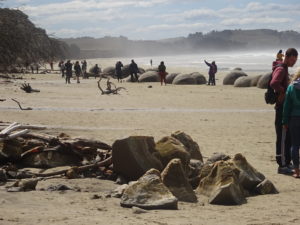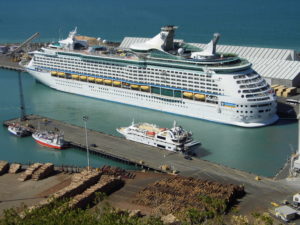Blog Categories
Blogroll
- Tony Jones on why your budget shouldn't matter…
- How UK Museums Use Mobile Tech to Enhance Visitor Experience
- David Brooks comments on the Experience Economy
- Excerpts from a paper by John A. Veverka
- Claire Ross outlines the digital age of visitor experiences
- What is the single most important aspect of the customer experience – Chris Bell
Posts Tagged ‘social license’
Naumai
It is always a privilege to “share” Aotearoa / New Zealand. It matters little if the audience is domestic or international , hitting the road to explore our place in the world is one of life’s pleasures.
This summer was however different. Tasked with sharing the southern part of the South Island with a group of international visitors (including over the Chinese New Year period) I reflected on what one might find.
Reading and listening to media headlines I was expecting a constant stream of polluting freedom campers, over priced food and lodging, little space, tired operators, and people literally everywhere – even in my normally quiet haunts and secluded places!
The trip took in every destination and more, between Christchurch and Bluff via the Catlins, Manapouri, Te Anau Queenstown and Wanaka.
So summing up the trip was a great success, we achieved most things we promised our visitors and more. We saw rare and endangered wildlife, meet some fantastic locals, enjoyed great food and wine and the whole gambit of southern landscapes.
That of course is the official version.
My overwhelming impression after ten days on the road in the southern South Island, is of too many people in too many locations. I mean literally no one used to go to Slope Point (the most southern point of mainland NZ) , a full car park at Bluff mid afternoon (great views) and absolutely no where to turn in Wanaka around 4pm.
I am apprehensive when I hear local operators saying that bookings for next year re even higher than this summer, in one case up to a third. What does that mean for tourism’s social license to operate?
Here are some facts:
The number of international visitors coming into NZ averages over 320,000 a month
This is an average yearly growth of over 5.65 for the last ten years
More than one in ten jobs is indirectly generated by tourism
International visitors contribute $ 40 million per day to the economy
And New Zealander’s (2017) views on tourism
96% of us agree tourism is good for NZ 35% think tourism puts too much pressure on NZ 21% think there are too many visitors
Challenges for NZ’s around international visitors include: road congestion, litter and a high risk of motor accidents
In earlier blogs we have discussed the opportunities and challenges for tourism in maintaining and enhancing a social license to operate. Some initiatives such as Tourism Aotearoa’s sustainable tourism are small step in the right direction. But if this years southern experience on the road is next years reality, then we have a serious problem – with no coordinated response in sight.
Ka kite ano
NZx – September 30th : how to boost your social license to operate
Naumai
Last month we looked at some views on why NZ tourism needs to develop it’s social license to operate.
As previously noted, there are many definitions of how to obtain and maintain a social license to operate. At the micro level it’s about the concept of a project achieving ongoing approval of the local community and other stakeholders. That may be formal through processes such as the RMA or the DOC concession process or informal such as access agreements.
At the macro level it is how industry sectors work at a national level along similar lines, and particularly how they influence government.
The opportunity to achieve a social license to operate can be seen as an overall outcome. There is no rule book which defines the process, a method, tools or ways to achieve such an outcome.That is both an advantage and disadvantage.
Gavin Shepherd in the Te Awamutu Courier argues, that for the farming sector, “long-term profits on farm are more linked to these social perceptions than efficiency in production or scale at all costs”.
Dan Ormond, formerly partner at Ideas Shop, notes that, along with knowledge of who your market is and its size, “all aspects of engaging with stakeholders and developing sustainable business practices need to be communicated well in order to keep your business’s social license to operate”.
So how do we achieve such a license?
There seems to be general agreement on the following processes:
- identify key stakeholders (people affected by the project/sector) and continue to review these
- gain social acceptance based around legal, social,and cultural norms – both formal and informal
- gain credibility based on accurate and transparent information and importantly delivering on promises and representations that have been given
- gain trust from the local or national community based on being accountable, collaborative and sharing experiences
- deliver extensive and wide ranging communications across all channels that integrate all of the above.
In terms of a tourism perspective we note Taleb Rifai, Secretary-General, World Tourism Organization (UNWTO) comments that “globally tourism is today the 3rd largest export industry in the world after chemicals and fuels. Last year alone, 1.235 million travellers crossed international borders in one single year. By 2030, this 1.2 billion will become 1.8 billion”. Globally tourism has sustainable development as a key plank in all its 5 pillars:
- Economic: yielding inclusive growth;
- Social: bringing decent jobs and empowering communities;
- Environmental: preserving and enriching the environment and addressing climate change;
- Cultural: celebrating and preserving diversity, identity, and tangible and intangible culture, and
- Peace: as an essential prerequisite for development and progress.
As an aside the UN General Assembly declared 2017 as the International Year of Sustainable Tourism for Development. Who knew?
In NZ tourism faces some political issues and community fears. As Professor Chris Ryan noted immediately after the election, all major parties played lip service to developing integrated tourism policy. This remains an ongoing challenge for the industry but should not deter Tourism Aotearoa , Tourism New Zealand local Regional Tourism Organizations and tourism operators doing more in this space.
Regular snapshots of how NZ communities view tourism show a trend towards less acceptance at the current and particularly the projected levels of international tourism.
In summary, achieving and maintaining a social license to operate is a dynamic, long-term, holistic and vitally important process for both key industry sectors and individual operators. The difference being primarily the scale of the input.
As social scientist Kate Brooks states “Any industry, that operates, particularly using common resources like water or land, forests, has to concern themselves with social license to operate issues. It’s like somebody saying I want to come in and use your front yard (for my own profit).”
Ka kite ano
Naumai
Continued growth in New Zealand tourism is raising questions over it’s social license to operate. As Tourism Aotearoa states ” Tourism will only achieve our Tourism 2025 aspirational goal if we maintain and enhance our social licence to operate. We are encouraging tourism operators to recognise the importance of growing their businesses in a way which balances the economic, social and environmental impacts.”
There is no widely accepted definition of a social license to operate (SLO). However a recent paper by the Sustainable Business Council suggests key attributes include:
Ka kite ano


